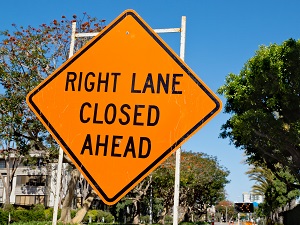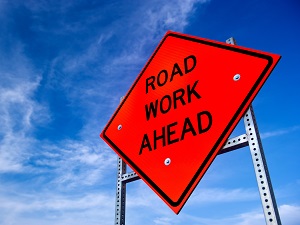Signage is a critical part of temporary traffic control (TTC) and contributes to the safety of the workers and all road users. Improper signage, or signs that are not visible because they are dirty or worn out, can confuse or frustrate motorists and lead to serious incidents in the work zone.

Temporary traffic control signs notify road users of specific roadway conditions that are now different from the normally traveled route. Warning signs may direct road users to a change to traffic flow speed or direction or provide attention to a roadway situation that is unusual or not immediately apparent without the use of signage.
When considering signage for temporary traffic control areas, workers must be aware of the component parts of a TTC zone which include:
- Advanced Warning > roadway users are informed about the activity ahead.
- Transition Area > traffic is directed from the normal path to a new course.
- Activity Area > the work zone.
- Termination Area > traffic is returned to the normal path.

Signs used for temporary traffic control must follow strict requirements to ensure that they are standardized, easily understandable, and recognizable to motorists. Signs must be large enough to be seen and placed at heights that will ensure they are visible to approaching traffic and pedestrians.
Based on traffic speed, use the following guidelines when deciding advance warning sign dimensions. For best performance, use larger signs, even in low-speed areas.
- High speed roadway (35 mph and above): 48 x 48 inches with uppercase lettering at least 7 inches high.
- Moderately low traffic volumes and speeds (25 to 35 mph): 36 x 36 inches, with uppercase lettering at least 5 inches high.
- Low speed local roads and streets (25 mph or below): 30 x 30 inches, with short sign messages that are clear in meaning.
Warning signs should be placed at a location so that drivers can see the sign before they encounter the TTC zone. When multiple advance warning signs are needed, the Road Work Ahead sign should be the first sign that road users see.
TTC signs should be placed on the right-hand side of the roadway.
- When special emphasis is needed, signs may be placed on both sides of road.
- Signs mounted on portable supports may be placed within the roadway.
- Signs may also be mounted on or above barricades.
- Sign supports should not be placed on areas designated for pedestrian or bicycle traffic.

Portable sign mounting is used for work zone applications that last less than 3 days. For work zone activity that will last longer than 3 consecutive days in one location, use post-mounted advance warning signs.
MUTCD Standard 6F.03-16 The bottom of a sign mounted on a barricade, or other portable support, shall be at least 1 foot above the traveled way.
For mobile operations, a sign may be mounted on a work vehicle, a shadow vehicle, or a trailer stationed in advance of the TTC zone or moving along with it. Vehicle-mounted signs should be high enough for adequate visibility for approaching vehicles, suggested at least 4 feet above the ground surface.

Warning signs should be placed in advance of the TTC zone at varying distances depending on roadway type, condition, and posted speed. It is important to refer to the correct Federal or State MUTCD standard for sign spacing requirements, depending on the location of the work.
Various conditions, such as limited sight distance or obstructions, that might require a driver to reduce speed or stop, might require additional advance warning signs. Appropriate spacing is crucial to allow road users time to react appropriately within the TTC zone. If road users don’t seem to be recognizing the signs, consider increasing the sign spacing, increasing the sign size, adding flags or adding warning lights.
General guidance from the MUTCD regarding sign spacing:
- 4 to 8 times the speed limit in urban areas
- 8 to 12 times the speed limit in rural locations
Typical distances for placement of advance warning signs on freeways and expressways should be longer because drivers are conditioned to uninterrupted flow and need additional reaction time. However, sometimes decreasing the sign spacing might be needed in order to place a sign immediately after an intersection so that traffic turning onto the roadway in the direction of the work zone will be warned right away.
Because work zones can sometimes be large and there might be several work spaces (some even separated by several miles) within the project limits, each work space should be adequately signed to inform road users and reduce confusion.
An END ROAD WORK sign, a Speed Limit sign, or other signs may be used to inform road users that they can resume normal operations. However, the End Road Work sign is recommended.

Crashworthy signs and devices attempt to minimize or prevent serious injuries or property damage in different ways, for example, a crashworthy device may:
- contain or redirect vehicles from impacting a hazardous feature, and/or
- decelerate an impacting vehicle gradually, and/or
- break away, fracture, or otherwise yield, if impacted.
For a sign or device to be considered crashworthy, it must have been successfully crash tested in accordance with a national standard.
MUTCD Standard 6F.03-09 Signs mounted on barricades and barricade/sign combinations shall be crashworthy. 6F.03-15 Sign supports shall be crashworthy. Where large signs having an area exceeding 50 square feet are installed on multiple breakaway posts, the clearance from the ground to the bottom of the sign shall be at least 7 feet.
Construct barricades and sign supports as specified; do not modify or deviate from the standard construction.
Signs should not be overly ballasted (weighted down/stabilized) with sand bags. Concrete, rocks, or other construction material should not be used for ballasting signs. For portable signs, ballasting should be limited to one sand bag height on the sign legs.
Signs should not be attached over existing signs on a temporary sign support or barricade. Repairs to signs should completely replace broken components (don’t just patch the broken pieces together).
Older sign supports that are not known to be crashworthy should be replaced with newer, crashworthy versions.

.jpg)

.jpg)